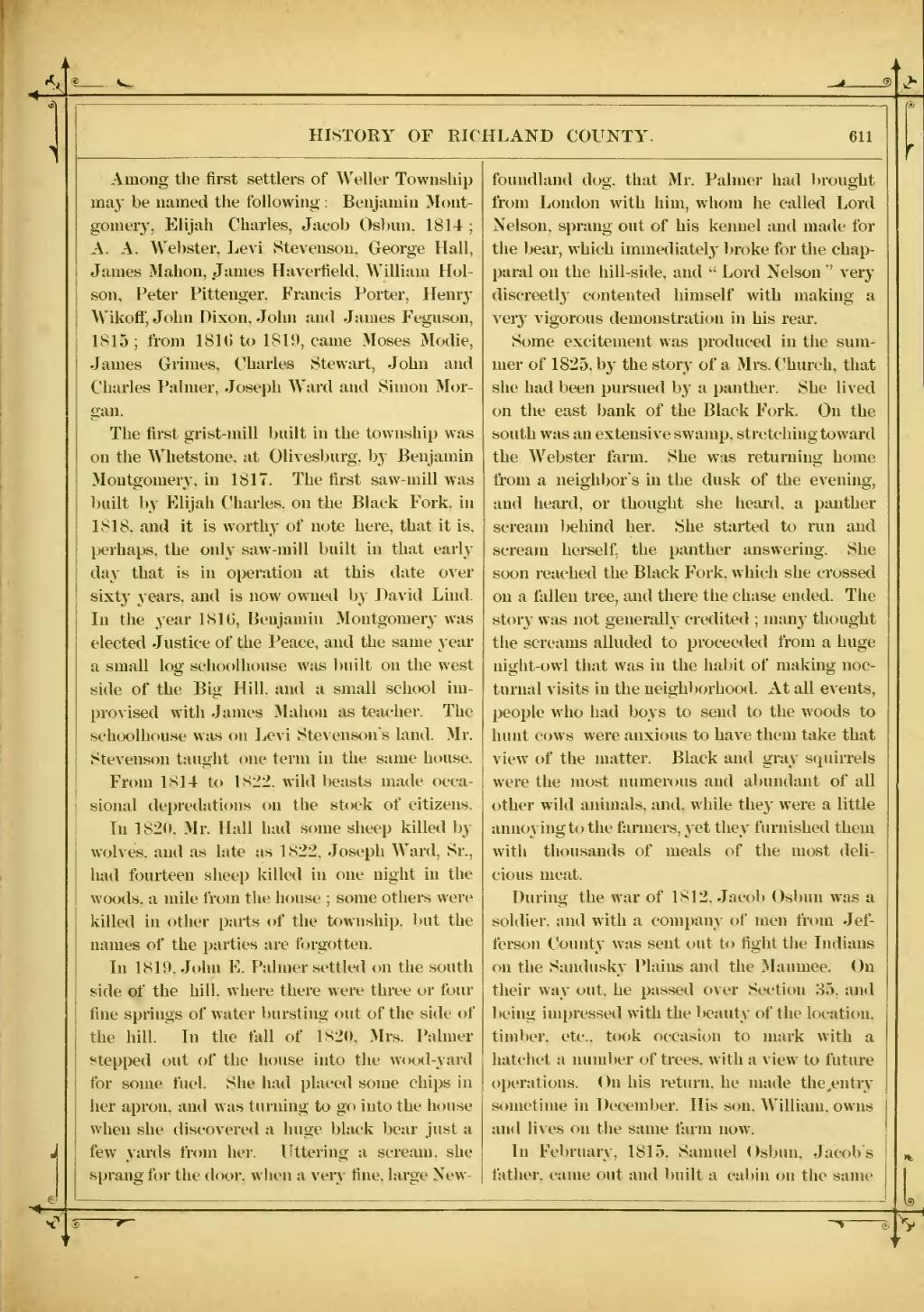HISTORY OF RICHLAND COUNTY.
��611
��Among the first settlers of Weller Township may be named the following : Benjamin Mont- gomer}', Elijah Charles, Jacob Osbun, 1814 ; A. A. Webster, Levi Stevenson, George Hall, James Mahon, James Havei-field, William Hol- son. Peter Pittenger. Francis Porter, Hemy Wikoff, John Dixon, John and James Feguson, 1815 ; from 1816 to 1819, came Moses Modie, James Grimes, Charles Stewart, John and Charles Palmer, Joseph Ward and Simon Mor- gan.
The first grist-mill built in the township was on the Whetstone, at Olivesburg, l:)j Benjamin Montgomer}-, in 1817. The first saw-mill was built by Elijah Charles, on the Black Fork, in 1818, and it is worthy of note here, that it is, perhaps, the onl}- saw-mill built in that early day that is in operation at this date over sixty years, and is now owned by David Lind. In the year 1816, Benjamin Montgomery was elected Justice of the Peace, and the same j-ear a small log schoolhouse was built on the west side of the Big Hill, and a small school im- provised with James Mahon as teacher. The schoolhouse was on Levi Stevenson's land. Mr. Stevenson taught one term in the same house.
From 1814 to 1822. wild beasts made occa- sional depredations on the stock of citizens.
In 1820, Mr. Hall had some sheep killed by wolves, and as late as 1822, Joseph Ward, Sr., had fourteen sheep killed in one night in the woods, a mile from the house ; some others were killed in other parts of the township, but the names of the parties are forgotten.
In 1819, John E. Palmer settled on the south side of the hill, where there were three or four fine springs of water bursting out of the side of the hill. In the fall of 1820. Mrs. Palmer stepped out of the house into the wood-yard for some fuel. She had placed some chips in her apron, and was turning to go into the house when she discovered a huge black bear just a few yards from her. Uttering a scream, she sprang for the door, when a very fine, large New-
��foundland dog, that Mr. Palmer had brought from London with him, whom he called Lord Nelson, sprang out of his kennel and made for the bear, which immediately broke for the chap- paral on the hill-side, and " Lord Nelson " very discreetly contented himself with making a A^er}' vigorous demonstration in his rear.
Some excitement was produced in the sum- mer of 1825, by the story of a Mrs. Church, that she had been pursued by a panther. She lived on the east bank of the Black Fork. On the south was an extensive swamp, stretching toward the Webster farm. She was returning home from a neighbor's in the dusk of the evening, and heard, or thought she heard, a panther scream behind her. She started to run and scream herself, the panther answering. She soon reached the Black Fork, which she crossed on a fallen tree, and there the chase ended. The story was not generall}- credited ; many thought the screams alluded to proceeded from a huge night-owl that was in the habit of making noc- turnal visits in the neighborhood. At all events, people who had boys to send to the woods to hunt cows were anxious to have them take that view of the matter. Black and gi'ay squirrels were the most numerous and abundant of all other wild animals, and, while they were a little annojing to the fanners, 3'et the}' furnished them with thousands of meals of the most deli- cious meat.
During the war of 1812, Jacob Osbun was a soldier, and with a compan}- of men from Jef- ferson Count}' was sent out to fight the Indians on the Sandusky Plains and the Maumee. On their way out, he passed over Section 35, and being inipi'essed with the beauty of the location, timber, etc.. took occasion to mark with a hatchet a number of trees, with a view to future operations. On his return, he made the^entrj- sometime in December. His son. William, owns and lives on the same farm now.
In February, 1815, Samuel Osbun. JacoV)s father, came out and built a cabin on the same
�� �
